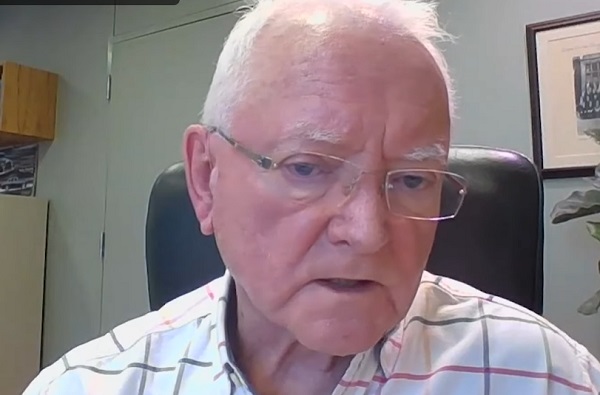Alberta
An Alternative View of COVID 19 in Alberta

I am Al Poole, retired Site Leader, NOVA Chemicals, Joffre site. Like everyone else, I’ve been overwhelmed with information about Covid 19. It is in my nature to ask questions – and keep asking until I get a satisfactory answer. As a former Site Leader at NOVA Chemicals, Joffre I am aware of what emergency response plans look like. This isn’t it
Why am I doing this?
- I accept that covid may be more contagious than other influenzas and requires thoughtful and well planned interventions to minimize the impact on all citizens (I say “may” as there is considerable disagreement on the PCR test method – even by its founder).. However, I am puzzled as to why the AB government and AHS will not consider the opposing opinions coming from other health and science experts. I suspect the truth is somewhere in the middle. Why are they so reluctant to engage other opinion to ensure we are on a productive path to protect all Albertans. I am surprised at how willingly many Albertans have accepted the ongoing dogma by our government, AHS and the media. Fear factor is something to worry about. I believe it results from sharing inaccurate models and the constant reporting of cases even though we know cases are not harmful to the vast majority of Albertans. Clearly – our media people are caught up in the fear factor. I hope people will read this and begin a process to become more informed on – What is And What isn’t – as it relates to Covid. People need to ask more questions – demand better information.
- Read these articles: one by David Redman on a proper Emergency Response Plan – why ignore it? https://c2cjournal.ca/2020/12/every-store-and-school-should-be-open-confronting-the-pandemic-with-confidence/ Second one – Great Barrington Declaration, written by some smart qualified medical people – why it is simply dismissed? https://gbdeclaration.org/
- See this article on our freedoms and rights in the National Post from Preston Manning https://nationalpost.com/opinion/preston-manning-lockdown-rules-are-violating-our-rights-im-calling-on-the-justice-minister-to-intervene
Remember:
1) At the outset we were alerted to the fact the virus (like flu viruses) is likely to mutate. Now – it has and continues to mutate. Even more concerning is the notion it only happens in other countries and can only enter Canada – versus accepting the mutation can happen here too.
2) Soon after governments accepted Covid was real and in Canada they declared, “we must protect our most vulnerable”. Everyone agreed! It still makes sense as one of the important objectives – but not the only one.
Perspective:
As of Jan 25rd in Alberta (Based on data from Alberta Gov’t interactive web site on Covid):
- Over 95% of people contracting the virus have few to no symptoms;
- Less than 5% are hospitalized;
- Less than a 1% in ICU;
- Average age is 82;
- No one under the age of 20 has died.
Across Canada over 80% of deaths are in Long Term Care Facilities (most vulnerable).
So – how have they done protecting the most vulnerable? They have done a miserable job – and I am not surprised. They were offered an emergency response plan but chose to ignore it. The plan outlined by Mr. Redman is consistent with my Emergency Preparedness and Response training and experience. Further, as soon as you enter the realm of personal protective equipment to protect people from respiratory infection – you are into seriously rigid procedures. I have seen no evidence of meaningful procedures.
Deaths (using 4,400,000 as Alberta population – actual slightly higher):
- Covid deaths (1549): 0.04%
- Annual deaths (from all causes in 2019 – over 26,000): 0 .6%
- Deaths among elderly continue to rise – no surprise as they did not protect most vulnerable.
Age at death (comorbidities a major factor in most of these deaths):
- 80+ – 1030
- 70s – 316
- 60s – 160
- 50s – 50
In summary:
I worry the hype of new strains will lead gov’t to more and longer lockdown restrictions with out any realization these same actions have made it worse for our most vulnerable and have made it worse for so many other Albertans.. A good Emergency Response Plan would have done a better job of protecting our most vulnerable – less deaths – less load on hospitals and much less impact on Alberta citizens and way of life. It is not too late to rethink the covid approach to something more effective in protecting our most vulnerable and getting Alberta citizens and businesses moving back toward normal life and operations.
In closing, Covid has had an impact on us — for two of our three children – have experienced work interruptions. Our oldest is in essential services (Ontario) so continues to work. However, her son, our grandson at 13 is negatively impacted, by isolation and not being in a classroom, during a most important time of his life. Also, I have a 92 year old mom in good mental and physical health – more negatively impacted by isolation. As she said to me this summer, “for heavens sake Allan, I am 92 – what are they thinking”. She was so upset she could not hug two of her children who were allowed a ‘distance visit’.
I am still puzzled and wondering – what are they (gov’t and AHS) trying to protect? Their actions and decisions to date make no sense.
I encourage everyone to become more informed and start asking a lot more questions. We are entitled to better leadership and meaningful information from our government. Here are my questions :
- What is the truth on PCR testing? We want data not just your opinion.
- Why is the death rate so high in LTC – from March 2020 until now?
- Why is most testing related to multiple test for same people – suggests spread is in hot zones (LTC facilities).
- Why are so many business still under lockdown restrictions?
“What are your questions?”
Alberta
Medical regulator stops short of revoking license of Alberta doctor skeptic of COVID vaccine

From LifeSiteNews
The Democracy Fund has announced that COVID-skeptic Dr. Roger Hodkinson will retain his medical license after a successful appeal against allegations of ‘unprofessional conduct’ by the College of Physicians and Surgeons of Alberta.
A doctor who called for officials to be jailed for being complicit in the “big kill” caused by COVID measures will get to keep his medical license thanks to a ruling by a Canadian medical regulator.
The Democracy Fund (TDF) announced in an April 4 press release that one of its clients, Dr. Roger Hodkinson, will retain his medical license after filing an appeal with the College of Physicians and Surgeons of Alberta (CPSA) over allegations of “unprofessional conduct regarding 17 public statements made in November 2020 and April 2021.”
Hodkinson had routinely argued against the dictates of public health and elected officials and “presented an alternative perspective on COVID-19, including the efficacy of masking and vaccines,” TDF noted.
In 2021, Hodkinson and Dr. Dennis Modry publicly blasted the then-provincial government of Alberta under Premier Jason Kenney for “intimidating” people “into compliance” with COVID-19 lockdowns.
In 2022, Hodkinson said that leaders in Canada and throughout the world have perpetrated the “biggest kill ever in medicine’s history” by coercing people into taking the experimental COVID injections and subjecting them to lengthy lockdowns.
These statements, among others, led the CPSA to claim that Hodkinson had promoted inaccurate or misleading information. “However, following negotiations with lawyers for The Democracy Fund, the CPSA limited its claims to arguing that Dr. Hodkinson’s comments violated the ethical code and extended beyond the scope of a general pathologist.”
Thus, Hodkinson did not “concede that any of his statements were false,” but “acknowledged that his criticisms of other physicians technically breached the Code of Ethics and Professionalism,” the group explained. “He also admitted that he should have clarified that his views were outside the scope of a general pathologist.”
Instead of having his license revoked, TDF stated that Dr. Hodkinson received a “caution” and will have to “complete an online course on influence and advocacy.”
“However, he did not concede that any of his statements were misinformation, nor did the tribunal make such a determination,” noted lawyer Alan Honner.
While Hodkinson received a slap on the wrist, a number of Canadian doctors have faced much harsher sanctions for warning about the experimental vaccines or other COVID protocols such as lockdowns, including the revocation of their medical licenses, as was the case with Dr. Mark Trozzi and others.
Some of Hodkinson’s warnings seem to have been vindicated by the current Alberta government under Premier Danielle Smith, who commissioned Dr. Gary Davidson to investigate the previous administration’s handling of COVID-19.
Davidson’s report, which was made public earlier this year, recommended the immediately halt of the experimental jabs for healthy children and teenagers, citing the risks the shots pose.
Alberta
Province introducing “Patient-Focused Funding Model” to fund acute care in Alberta

Alberta’s government is introducing a new acute care funding model, increasing the accountability, efficiency and volume of high-quality surgical delivery.
Currently, the health care system is primarily funded by a single grant made to Alberta Health Services to deliver health care across the province. This grant has grown by $3.4 billion since 2018-19, and although Alberta performed about 20,000 more surgeries this past year than at that time, this is not good enough. Albertans deserve surgical wait times that don’t just marginally improve but meet the medically recommended wait times for every single patient.
With Acute Care Alberta now fully operational, Alberta’s government is implementing reforms to acute care funding through a patient-focused funding (PFF) model, also known as activity-based funding, which pays hospitals based on the services they provide.
“The current global budgeting model has no incentives to increase volume, no accountability and no cost predictability for taxpayers. By switching to an activity-based funding model, our health care system will have built-in incentives to increase volume with high quality, cost predictability for taxpayers and accountability for all providers. This approach will increase transparency, lower wait times and attract more surgeons – helping deliver better health care for all Albertans, when and where they need it.”
Activity-based funding is based on the number and type of patients treated and the complexity of their care, incentivizing efficiency and ensuring that funding is tied to the actual care provided to patients. This funding model improves transparency, ensuring care is delivered at the right time and place as multiple organizations begin providing health services across the province.
“Exploring innovative ways to allocate funding within our health care system will ensure that Albertans receive the care they need, when they need it most. I am excited to see how this new approach will enhance the delivery of health care in Alberta.”
Patient-focused, or activity-based, funding has been successfully implemented in Australia and many European nations, including Sweden and Norway, to address wait times and access to health care services, and is currently used in both British Columbia and Ontario in various ways.
“It is clear that we need a new approach to manage the costs of delivering health care while ensuring Albertans receive the care they expect and deserve. Patient-focused funding will bring greater accountability to how health care dollars are being spent while also providing an incentive for quality care.”
This transition is part of Acute Care Alberta’s mandate to oversee and arrange for the delivery of acute care services such as surgeries, a role that was historically performed by AHS. With Alberta’s government funding more surgeries than ever, setting a record with 304,595 surgeries completed in 2023-24 and with 310,000 surgeries expected to have been completed in 2024-25, it is crucial that funding models evolve to keep pace with the growing demand and complexity of services.
“With AHS transitioning to a hospital-based services provider, it’s time we are bold and begin to explore how to make our health care system more efficient and manage the cost of care on a per patient basis. The transition to a PFF model will align funding with patient care needs, based on actual service demand and patient needs, reflecting the communities they serve.”
“Covenant Health welcomes a patient-focused approach to acute care funding that drives efficiency, accountability and performance while delivering the highest quality of care and services for all Albertans. As a trusted acute care provider, this model better aligns funding with outcomes and supports our unwavering commitment to patients.”
“Patient-focused hospital financing ties funding to activity. Hospitals are paid for the services they deliver. Efficiency may improve and surgical wait times may decrease. Further, hospital managers may be more accountable towards hospital spending patterns. These features ensure that patients receive quality care of the highest value.”
Leadership at Alberta Health and Acute Care Alberta will review relevant research and the experience of other jurisdictions, engage stakeholders and define and customize patient-focused funding in the Alberta context. This working group will also identify and run a pilot to determine where and how this approach can best be applied and implemented this fiscal year.
Final recommendations will be provided to the minister of health later this year, with implementation of patient-focused funding for select procedures across the system in 2026.
-

 Courageous Discourse2 days ago
Courageous Discourse2 days agoEurope Had 127,350 Cases of Measles in 2024
-

 Podcasts1 day ago
Podcasts1 day agoTrump’s Tariffs: The US, Canada, and the rest of the world
-

 2025 Federal Election1 day ago
2025 Federal Election1 day agoMark Carney Comes to B.C. and Delivers a Masterclass in Liberal Arrogance
-

 Alberta1 day ago
Alberta1 day agoProvince introducing “Patient-Focused Funding Model” to fund acute care in Alberta
-

 Business1 day ago
Business1 day agoTrump threatens additional 50% tariffs on China, urges ‘patience’
-

 2025 Federal Election1 day ago
2025 Federal Election1 day agoPoilievre to invest in recovery, cut off federal funding for opioids and defund drug dens
-

 Business2 days ago
Business2 days agoJury verdict against oil industry worries critics, could drive up energy costs
-

 Business2 days ago
Business2 days agoTrump says tariffs on China will remain until trade imbalance is corrected





